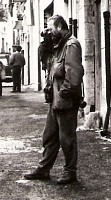BIOGRAPHY

1938-
Josef Koudelka, born in Moravia, made his first photographs while a student in the 1950s. About the same time that he started his career as an aeronautical engineer in 1961 he also began photographing Gypsies in Czechoslovakia and theater in Prague. He turned full-time to photography in 1967. The following year, Koudelka photographed the Soviet invasion of Prague, publishing his photographs under the initials P. P. (Prague Photographer) for fear of reprisal to him and his family. In 1969, he was anonymously awarded the Overseas Press Club's Robert Capa Gold Medal for those photographs.
His early work significantly shaped his later photography, and its emphasis on social and cultural rituals as well as death. He soon moved on to a more personal, in depth photographic study of the gypsies of Slovakia, and later Romania. This work was exhibited in Prague in 1967. Throughout his career, Koudelka has been praised for his ability to capture the presence of the human spirit amidst dark landscapes. Desolation, waste, departure, despair and alienation are common themes in his work. His characters sometimes seem to come out of fairytales. Still, some see hope within his work — the endurance of human endeavor, in spite of its fragility. His later work focuses on the landscape removed of human subjects.
Koudelka has won significant awards such as the Prix Nadar (1978), a Grand Prix National de la Photographie (1989), a Grand Prix Cartier-Bresson (1991), and the Hasselblad Foundation International Award in Photography (1992). Significant exhibitions of his work have been held at the Museum of Modern Art and the International Center of Photography, New York; the Hayward Gallery, London; the Stedelijk Museum of Modern Art, Amsterdam; and the Palais de Tokyo, Paris.
